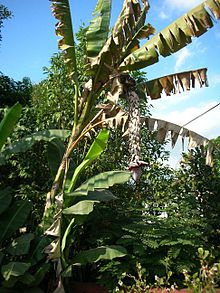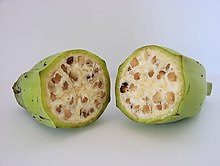

| Musa balbisiana | |
|---|---|

| |

| |
| The fruit of M. balbisiana, showing numerous seeds | |
| Scientific classification | |
| Kingdom: | Plantae |
| Clade: | Tracheophytes |
| Clade: | Angiosperms |
| Clade: | Monocots |
| Clade: | Commelinids |
| Order: | Zingiberales |
| Family: | Musaceae |
| Genus: | Musa |
| Section: | Musa sect. Musa |
| Species: |
M. balbisiana
|
| Binomial name | |
| Musa balbisiana | |

| |
| Original native ranges of the ancestors of modern edible bananas: M. acuminata is shown in green and M. balbisiana in orange.[3] | |
| Synonyms[4] | |
Musa balbisiana, also known simply as plantain, is a wild-type species of banana. It is one of the ancestors of modern cultivated bananas, along with Musa acuminata.
It grows lush leaves in clumps with a more upright habit than most cultivated bananas. Flowers grow in inflorescences coloured red to maroon. The fruit are between blue and green. They are considered inedible because of the seeds they contain.
It was first scientifically described in 1820 by the Italian botanist Luigi Aloysius Colla.[2][5]
It is native to eastern South Asia, the eastern regions of the Indian subcontinent, northern Southeast Asia, and southern China. Introduced populations exist in the wild, far outside its native range.[6]
It is assumed that wild bananas were cooked and eaten, as farmers would not have developed the cultivated banana otherwise. Seeded Musa balbisiana fruit are called butuhan ('with seeds') in the Philippines,[7] and kluai tani (กล้วยตานี) in Thailand,[8] where its leaves are used for packaging and crafts.[9] Natural parthenocarpic clones occur through polyploidy and produce edible bananas, examples of which are wild saba bananas.[10]
Musa balbisiana contributed the B genome to the cultivated banana.[11]
Wang et al., 2019 provides a genome, evolutionary analysis and functional genomics analysis.[11] Wang et al. find evolution increasing ethylene production in the domesticated form.[11]
|
| |||||||||||||||||||||
|---|---|---|---|---|---|---|---|---|---|---|---|---|---|---|---|---|---|---|---|---|---|
| |||||||||||||||||||||
| |||||||||||||||||||||
| Musa balbisiana |
|
|---|---|
This fruit-related article is a stub. You can help Wikipedia by expanding it. |